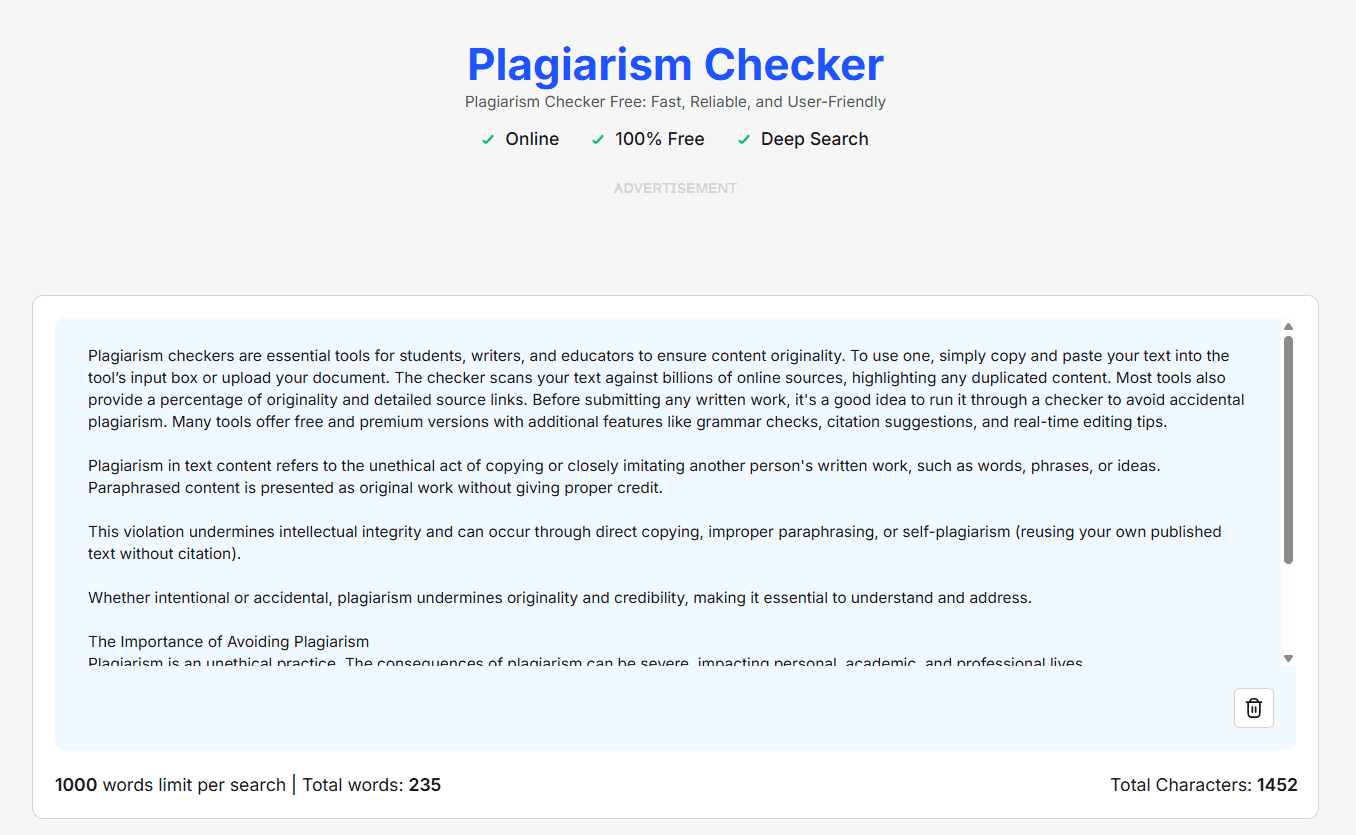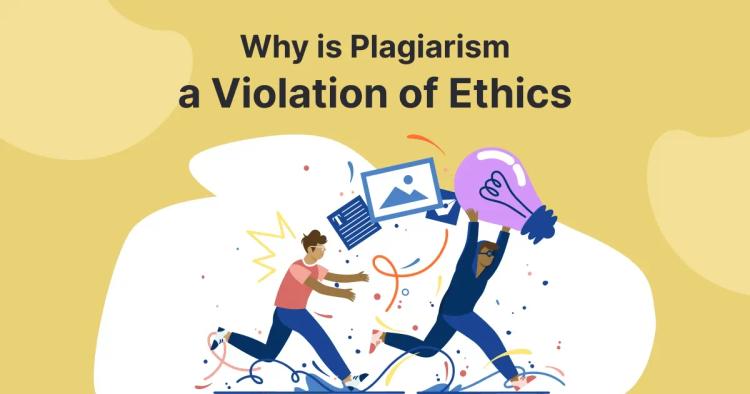Whether you are writing an essay for school, or a research paper for a famous scientific journal, you will most probably use outside sources for information and references.
Sometimes plagiarism can creep in even if you are careful. This is where using a plagiarism checker makes it easier to ensure you cited all your sources properly and your piece is original. Fortunately, they are simple to use.
ᴀᴅᴠᴇʀᴛɪsᴇᴍᴇɴᴛ
What Is Plagiarism
Plagiarism is using someone else’s words or ideas without giving credit. It is simply stealing and can lead to serious consequences.
You can avoid plagiarism with proper citation, using quotes and generally mentioning your sources, though. The tricky bit is that there are different types of plagiarism.
From copying text word-for-word, paraphrasing too closely, self-plagiarism (reusing your past work), to even accidental plagiarism.
Why Use a Plagiarism Checker
They help you avoid plagiarism and catch the sections that are being flagged as duplicate.
When you write an essay for school, or a research paper, you will inevitably use outside sources - unless all of your research is primary. It is practically impossible to compare your final piece with all the content that is out there manually to check for plagiarism.
An online plagiarism checker lets you check for similarities quite easily by automating the entire process. Moreover, it can improve writing quality, protect your reputation, and help with getting your research of college essays published without any roadblocks.
Plagiarism checkers can prevent Google from seeing your site as duplicate content which can hurt your SEO too. Good tools are intuitive to use and scans online sources and highlights matches so you can fix issues early.
ᴀᴅᴠᴇʀᴛɪsᴇᴍᴇɴᴛ
How To Use a Plagiarism Checker
CopyChecker gives you high-quality plagiarism checkering for free. It is easy to use and does a deep search across our extensive database to check for duplicates in your text. Here is a step by step guide on how to use it:
Step 1: Paste Your Text Into The Input Box

Go to our online tool. Grab the text you want to scan and paste it straight into the input box. Make sure you’re pasting the complete content you need to check so the tool can run a thorough scan.
Step 2: Click “Check Plagiarism”

Once your text is in place, click the “Check Plagiarism". The tool will begin comparing your text against a large database of web pages, academic papers, and other sources. This part usually takes less than a minute for shorter documents. However longer essays or research papers might need a bit more time.
Step 3: Analyze Results

When the scan is done, you will see a similarity percentage and a detailed report along with the sources your content matched with. You can click the sources to go to the links directly.
You can also check the content you pasted and see if you would want to recheck as well:

How To Interpret Plagiarism Checker Results
Start by looking at the overall percentage. A low score between 0-5% often means you are in the clear. Review and cross check your writing with the sources too.
Oftentimes you will see portions of your writing as plagiarized. However, one of the ways these tools check for duplicate content is by exact-matching your writing with other sources.
So, you might also get small amounts of false positives. This is where some manual checking comes in handy.
You might also be flagged for plagiarism if you use AI. So, writing the piece yourself is best. Lastly, to get rid of all kinds of plagiarism, make sure to cite the sources of the parts that were shown as plagiarised.
There are no universally accepted plagiarism percentages. However, usually academic institutions allow about 10-15% plagiarism.
Whereas for dissertations and thesis, single digit percentages are acceptable. But the general rule is the lower the percentage the better - aim for single digit percentages.
Who Is a Plagiarism Checker For?
Anyone who creates content, really. Students use one to avoid plagiarism in academic writing and make sure essays and term papers are original. Teachers rely on checkers to spot copied work in assignments.
Bloggers and marketers use them to detect plagiarism online so their content does not get flagged by Google. Even researchers use tools for cross-language plagiarism detection when translating studies.
Basically, if you write or publish anything—academic, professional, or online—you need a checker.
How To Choose The Best Plagiarism Checker
There are many plagiarism checking tools out there. But not all made the same. Here are some factors to keep in mind when choosing the best plagiarism checker.
Database Size and Coverage
A larger database means better chances to catch matches. Look for tools that scan academic papers, websites, and books.
Accuracy
Accuracy is one of the most crucial factors when choosing a plagiarism checker. Ensure the one you use advanced algorithms to check your content precisely for matches.
Reporting Features
You want a clear interpretation of the plagiarism report page with highlighted text, source links, and percentage scores. This will help you make quick and decisive changes easily.
Integration with Writing Software
This one is a quality of life feature that will also make your life easier. After you check plagiarism, you can head over to our grammar checker to polish your writing for a cohesive final output.
ᴀᴅᴠᴇʀᴛɪsᴇᴍᴇɴᴛ
Frequently Asked Questions
Is a plagiarism checker accurate?
Plagiarism checkers vary. Some versions catch basic copied text but might miss paraphrased content. Our tool has an extensive database which it checks your texts against to give you accurate results.
Can you check plagiarism on Google Doc or Microsoft Word?
Yes. Some tools offer a plagiarism checker for Google Docs add-on or a Microsoft Word plugin. You can also export your document as a file and upload it to an online plagiarism detection tool.
How do plagiarism checkers work?
They compare your text against billions of web pages, academic papers, and other sources. The tool highlights matches and gives a similarity score to help you see what needs fixing.
What is the best way to avoid plagiarism?
Use a checker early, paraphrasing tool to avoid plagiarism if needed, and add citations for any direct quotes. Learn plagiarism prevention strategies so you can spot trouble before you write.
How to check documents for plagiarism without paying?
We offer a high quality free tool to detect plagiarism. Just paste your content to our free plagiarism checker and hit “Check Plagiarism”.
Does AI content count as plagiarism?
Yes, using AI to create content will count as AI plagiarism. You should ideally do LLMs for research, but write the piece yourself.
Can I avoid plagiarism while using AI tools?
Yes. If you use AI to generate text, run the output through a checker and rewrite any flagged sections to avoid plagiarism while using AI tools. Cite any unique phrases or facts that came from the AI.
ᴀᴅᴠᴇʀᴛɪsᴇᴍᴇɴᴛ
Wrapping Up
Using a plagiarism checker is easy if you follow this step by step plagiarism checker guide. Choose the right tool—free or paid—upload your text, and learn to interpret plagiarism report results.
Whether you want to avoid plagiarism in academic writing, research papers, or for your website copy, a fast and accurate checker saves time and stress. Remember to cite properly, paraphrase correctly, and re-scan your text until the similarity score is low.







